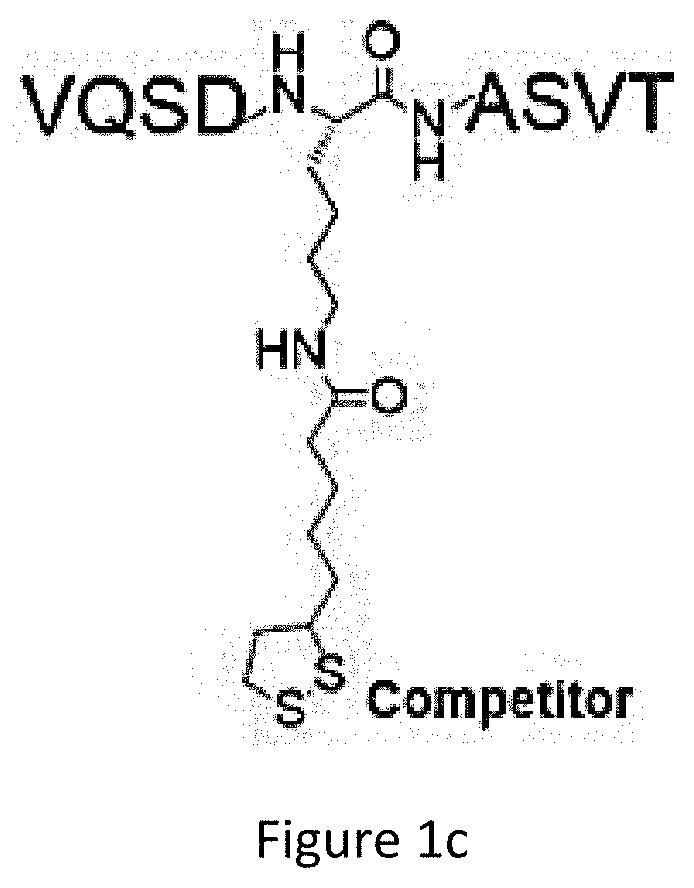Compound and a method for identifying a protein using said compound
a protein and compound technology, applied in the field of compound and a method for identifying a protein using said compound, can solve the problems of malfunction of metabolic complexes, numerous diseases, and weak delipoylation activity of sirt4 in vitro
- Summary
- Abstract
- Description
- Claims
- Application Information
AI Technical Summary
Benefits of technology
Problems solved by technology
Method used
Image
Examples
example 1
of KPlip
[0068]Profiling the interaction between an enzyme and its substrate may be difficult, as their interactions are usually weak, transient, and dynamic. Affinity-based probes (AfBPs) provide a powerful tool to overcome those hindrances by utilizing photo-crosslinking to convert transient protein-ligand interactions into covalent chemical linkages. Chemical proteomics using AfBP s coupled to mass spectrometry is a robust strategy that facilitates elucidation of complex molecular mechanisms by studying protein-ligand interactions within signaling networks.
[0069]The AfBP, KPlip (FIG. 1a), was synthesised on the basis of a peptide sequence derived from BCKDH protein (K105, QSDKlipASVT). In the probe design, the N-terminal Gln residue was replaced by a photo-cross-linker. To synthesize KPlip, the peptide was first assembled by the standard Fmoc solid phase peptide synthesis (SPPS) method. The Mtt group in the peptide was then deprotected to allow the installation of a lipoyl group. ...
example 2
Proteomic Profiling Using the Probe KPlip
[0070]Using the two probes (KPlip and KPlip-C). Chemical proteomics experiments were performed. An overview of the chemical proteomics methodology is shown in FIG. 3. The chemical proteomics sought to identify potential interacting proteins of KPlip in the cellular environment. To minimize “false hits” produced by nonspecific protein binding, probe KPlip-C was used in parallel as a negative control. The probes (10 μM) were incubated with live HEK 293 cells or cell lysates for 2 h. Following ultraviolet (UV) irradiation, the KPlip / KPlip-C-labelled proteomes were clicked with biotin azide, enriched by affinity purification, resolved by SDS-PAGE, and finally analysed by LC-MS / MS. Upon removal of nonspecific binding proteins identified from the control probe KPlip-C, only the proteins that were positively identified in both lysate and live-cell experiments were chosen as potential targets. This led to a probe-selectivity list of 419 protein candi...
example 3
belling of KPlip
[0074]The labelling efficiency of KPlip with recombinant Sirt2 was investigated. The Sirt2 enzyme was first incubated with either KPlip or a negative control probe, KPlip-C (lacking lipoylation), followed by 15 min of UV irradiation. Following click chemistry with rhodamine azide (Rh-N3), the reaction mixtures were resolved by SDS-PAGE and analysed by in-gel fluorescence scanning. The results showed that Sirt2 was labelled by KPlip efficiently, whereas no labelling was observed in the control probe KPlip-C, indicating that Sirt2 interacted with the probe KPlip by specifically recognizing the Klip moiety. Time-dependent experiments showed that 2 min UV irradiation resulted in intense labelling. The fluorescence intensity of the labelled Sirt2 band increased when the concentrations of the probe increased, demonstrating that probe KPlip labelled the target protein in a concentration-dependent manner.
[0075]A further selectivity study was performed. This study revealed th...
PUM
| Property | Measurement | Unit |
|---|---|---|
| pH | aaaaa | aaaaa |
| temperature | aaaaa | aaaaa |
| temperature | aaaaa | aaaaa |
Abstract
Description
Claims
Application Information
 Login to View More
Login to View More - R&D
- Intellectual Property
- Life Sciences
- Materials
- Tech Scout
- Unparalleled Data Quality
- Higher Quality Content
- 60% Fewer Hallucinations
Browse by: Latest US Patents, China's latest patents, Technical Efficacy Thesaurus, Application Domain, Technology Topic, Popular Technical Reports.
© 2025 PatSnap. All rights reserved.Legal|Privacy policy|Modern Slavery Act Transparency Statement|Sitemap|About US| Contact US: help@patsnap.com



